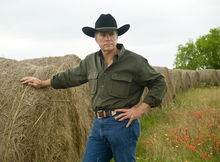With the approach of cooler weather, pastures are going dormant, hay bales, and, in some areas, haylage have been stored and are now beginning to be fed to horses. The threat of botulism contamination of hay and haylage is a seasonal concern for horse owners.

Botulism contamination possible in hay
In spite of vaccination and careful management, horses can be affected by the devastating disease of botulism, but quick action can save lives.
The botulism bacterium is a spore-forming bacteria that grows in the absence of oxygen and is found world-wide. It is present in soil and in decaying animal carcasses.
Although it occurs less often in decaying plant material, hay can be contaminated during the raking and bailing process. Haylage with its higher moisture levels, a pH above 4.5 and anaerobic conditions provides ideal conditions for the growth of Clostridium botulism.
When the bacterium grows, it produces toxins that block the connection between the nerves and muscles. Affected horses often exhibit signs varying from muscle weakness to paralysis, and they eventually die when their respiratory muscles become paralyzed, or when other health problems arise from being down.
Although horse owners are urged to vaccinate their horses against botulism, the dangerous effects of Clostridium botulinum toxins only Type B vaccinations are licensed for use in horses out of the seven possible types.
Botulism intoxication occurs rapidly and quickly becomes lethal.
According to the Kentucky Equine Research team, the stages of botulism intoxication and its effects happen quickly and require immediate action on the part of horse owners and veterinarians.
Stage One: Delivery of the toxicant from the site of exposure to its target. Horses have two susceptible exposure sites: the gastrointestinal tract and wounds. The gastrointestinal tract can be exposed to botulinum toxin by ingesting the toxin directly, or by ingesting bacteria that colonize and begin producing the toxin.
The toxin is absorbed into the bloodstream from the gastrointestinal tract. Wounds, especially deep puncture wounds or those with necrotic tissue, support the growth of C. botulinum bacteria. As the bacteria produce the toxin, it is absorbed into the bloodstream from the wound.
Once in the bloodstream the toxin circulates in search of its target molecule. Botulinum toxins have remarkable specificity, and their target molecule is a protein found in the peripheral terminals of motorneuron endplates. Motorneurons are part of the central nervous system (CNS), and their axons extend outside the CNS in order to control muscle function.
Stage Two: Reaction of the toxicant with its target. When a toxicant reaches its target molecule, it may bind to or alter that molecule. Botulinum toxin acts enzymatically on a specific target protein by acting as a zinc-protease.
The toxin prevents the release of acetylcholine at motorneuron endplates, thus affecting the transmission of impulses between endplates and nerves. Another known toxin having a zinc-protease lethal factor is anthrax, which causes cell death by inactivating mitogen-activated protein kinase kinase (MAPKK).
Stage Three: Cellular dysfunction and the resulting toxicities. Botulinum toxin causes cellular dysfunction by binding to the presynaptic membrane of cholinergic terminals and blocking the transmission of acetylcholine. Occurring at the endplate between the neuron and muscle cell, it manifests as muscle weakness that rapidly progresses to paralysis.
Stage Four: Inappropriate repair and adaptation. No repair mechanism exists for extraction of the botulinum toxin after it has reached and reacted with its target molecule. The bond between the toxin and the protein receptor is irreversible.
If the influx of the toxin can be stopped or mitigated by the administration of antitoxin, the horse can begin synthesizing new neuromuscular junctions.
The antitoxin can only bind to free, unbound botulinum toxin and not to toxin already affecting nerves. Unfortunately, the seven to ten days required for new growth is often more time than the horse has before paralysis of the diaphragm (the last muscle affected by the toxin) and respiratory paralysis occurs.
Understanding how the botulinum toxin works illustrates how imperative quick action is when faced with possible intoxication. It also underscores just how effective and deadly this toxin can be. Even with vaccination and careful management, horses can be affected by this devastating disease.
